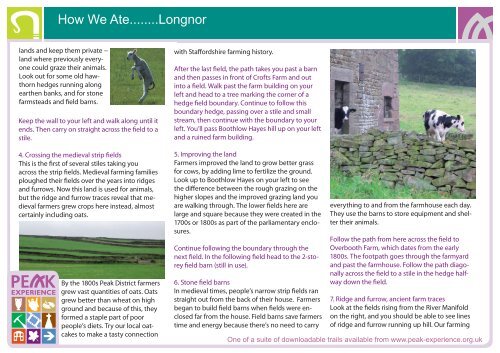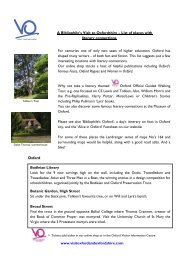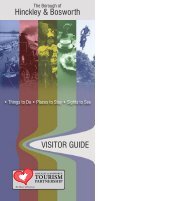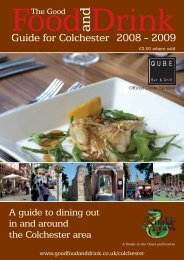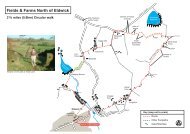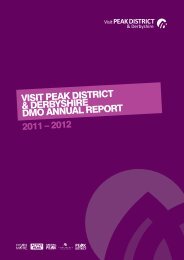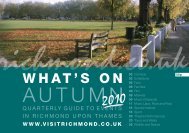Longnor - land of cheese! Trail Summary - Thedms.co.uk
Longnor - land of cheese! Trail Summary - Thedms.co.uk
Longnor - land of cheese! Trail Summary - Thedms.co.uk
You also want an ePaper? Increase the reach of your titles
YUMPU automatically turns print PDFs into web optimized ePapers that Google loves.
How We Ate........<strong>Longnor</strong><br />
Transport<br />
<strong>land</strong>s and keep them private −<br />
<strong>land</strong> where previously Circular everyone<br />
<strong>co</strong>uld graze their animals. km along moderately easy<br />
walk <strong>of</strong> roughly 4½<br />
Look out for some old tracks hawthorn<br />
hedges Distance running wood<strong>land</strong> along and heather<br />
through streamside<br />
earthen banks, and for stone<br />
4 km moor<strong>land</strong>, including some<br />
farmsteads and field barns.<br />
3<br />
ascents. Option to add a 2½<br />
miles<br />
km round trip through the<br />
Keep the wall to your left and walk along until it<br />
Allow<br />
ends. Then carry on straight National across Trust’s the field Longshaw to a<br />
stile.<br />
Estate via a tea room and<br />
2hr shop in a former hunting<br />
4. Crossing the medieval lodge. strip fields<br />
This is the Diffi first culty <strong>of</strong> several stiles taking you<br />
across the strip fields. Medieval farming families<br />
ploughed their fields over the years into ridges<br />
and furrows. Now this <strong>land</strong> is used for animals,<br />
but the ridge and furrow traces reveal that medieval<br />
farmers grew crops here instead, almost<br />
certainly including oats.<br />
<strong>Trail</strong> <strong>Summary</strong><br />
By the 1800s Peak District farmers<br />
grew vast quantities <strong>of</strong> oats. Oats<br />
grew better than wheat on high<br />
ground and because <strong>of</strong> this, they<br />
formed a staple part <strong>of</strong> poor<br />
people’s diets. Try our local oatcakes<br />
to make a tasty <strong>co</strong>nnection<br />
with Staffordshire farming history.<br />
After the last field, the path takes you past a barn<br />
and then passes in front <strong>of</strong> Cr<strong>of</strong>ts Farm and out<br />
into a field. Walk past the farm building on your<br />
left and head to a tree marking the <strong>co</strong>rner <strong>of</strong> a<br />
hedge field boundary. Continue to follow this<br />
boundary hedge, passing over a stile and small<br />
stream, then <strong>co</strong>ntinue with the boundary to your<br />
left. You’ll pass Boothlow Hayes hill up on your left<br />
and a ruined farm building.<br />
5. Improving the <strong>land</strong><br />
Farmers improved the <strong>land</strong> to grow better grass<br />
for <strong>co</strong>ws, by adding lime to fertilize the ground.<br />
Look up to Boothlow Hayes on your left to see<br />
the difference between the rough grazing on the<br />
higher slopes and the improved grazing <strong>land</strong> you<br />
are walking through. The lower fields here are<br />
large and square because they were created in the<br />
1700s or 1800s as part <strong>of</strong> the parliamentary enclosures.<br />
Continue following the boundary through the<br />
next field. In the following field head to the 2-storey<br />
field barn (still in use).<br />
6. Stone field barns<br />
In medieval times, people’s narrow strip fields ran<br />
straight out from the back <strong>of</strong> their house. Farmers<br />
began to build field barns when fields were enclosed<br />
far from the house. Field barns save farmers<br />
time and energy because there’s no need to carry<br />
everything to and from the farmhouse each day.<br />
They use the barns to store equipment and shelter<br />
their animals.<br />
Follow the path from here across the field to<br />
Overbooth Farm, which dates from the early<br />
1800s. The footpath goes through the farmyard<br />
and past the farmhouse. Follow the path diagonally<br />
across the field to a stile in the hedge halfway<br />
down the field.<br />
7. Ridge and furrow, ancient farm traces<br />
Look at the fields rising from the River Manifold<br />
on the right, and you should be able to see lines<br />
<strong>of</strong> ridge and furrow running up hill. Our farming<br />
One <strong>of</strong> a suite <strong>of</strong> downloadable trails available from www.peak-experience.org.<strong>uk</strong>


